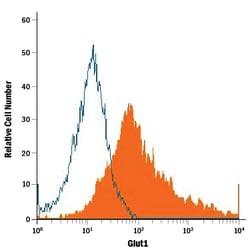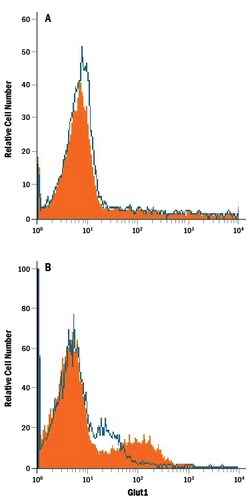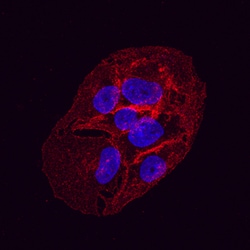Promotional price valid on web orders only. Your contract pricing may differ. Interested in signing up for a dedicated account number?
Learn More
Learn More
Human Glut1 Antibody, R&D Systems™


Mouse Monoclonal Antibody has been used in 12 publications
Supplier: R&D Systems MAB1418SP
This item is not returnable.
View return policy
Description
Glut1 Monoclonal specifically detects Glut1 in Human samples. It is validated for Flow Cytometry, Immunocytochemistry, CyTOF-ready.Specifications
| Glut1 | |
| Monoclonal | |
| Unconjugated | |
| Lyophilized from a 0.2 μm filtered solution in PBS with Trehalose. *Small pack size (SP) is supplied as a 0.2 μm filtered solution in PBS. with No Preservative | |
| Choreoathetosis/Spasticity, Episodic (Paroxysmal Choreoathetosis), CSE, DYT17, DYT18, DYT9, EIG12, Glucose transporter type 1, erythrocyte/brain, GLUT-1, GLUT1DS, HepG2 glucose transporter, HTLVR, Human T-Cell Leukemia Virus (I and II) Receptor, MGC141895, MGC141896, PED, SLC2A1, solute carrier family 2 (facilitated glucose transporter), member 1, Solute Carrier Family 2 Member 1, solute carrier family 2, facilitated glucose transporter member 1 | |
| Mouse | |
| Protein A or G purified from hybridoma culture supernatant | |
| RUO | |
| 6513 | |
| Reconstitute at 0.5 mg/mL in sterile PBS. | |
| Use a manual defrost freezer and avoid repeated freeze-thaw cycles. 12 months from date of receipt, -20 to -70 degreesC as supplied. 1 month, 2 to 8 degreesC under sterile conditions after reconstitution. 6 months, -20 to -70 degreesC under sterile conditions after reconstitution. | |
| IgG2b |
| Flow Cytometry, Immunocytochemistry, CyTOF | |
| 202915 | |
| Flow Cytometry 0.25 ug/10^6 cells, Immunocytochemistry 8-25 ug/mL, CyTOF-ready | |
| AAA52571 | |
| SLC2A1 | |
| NS0 mouse myeloma cell line transfected with human Glut1 Met1-Val492 Accession # AAA52571 | |
| 25 μg | |
| Primary | |
| Detects human Glut1. Stains human Glut1-transfected NS0 cells, but not NS0 control transfectants. Although Human Glut1 Antibody detects Glut1 on the surface of T cells (1, 2), it does not detect it on erythrocytes (5). The reason for this discrepancy is not understood, but may be related to conformational or post-translational modification differences. | |
| Human | |
| Purified |
Product Content Correction
Your input is important to us. Please complete this form to provide feedback related to the content on this product.
Product Title
For Research Use Only
Spot an opportunity for improvement?Share a Content Correction


